Branding vs. Marketing? Why It’s the Wrong Question
The Confusion We Keep Seeing
Have you noticed all the social media posts and blogs giving side-by-side comparisons between branding and marketing?
"Branding = who you are. Marketing = how you get noticed."
"Branding and marketing are NOT the same thing."
"Branding is why. Marketing is how."
"Branding is who you are. Marketing is how you talk about it."
"Marketing ≠ Branding"
We Googled, and there are 1.270 billion results when you search "branding vs marketing." It's a popular topic but also one that's often misunderstood. The implication is that branding and marketing are two separate systems living in their own lanes.
A False Choice That's Costing You Clarity
The reality is that branding is not separate from marketing. It's a foundational part of it.
All of the examples above misuse the word marketing. What they're really describing is promotion, which is another piece of the marketing puzzle. (Remember the 4P's?) It's not branding vs. marketing. It's branding vs. promotion. Branding is the why. Promotion is the how. Marketing is the whole system that connects it all.
Too many teams frame branding and marketing as a choice, competing priorities rather than interdependent functions. Thinking of and treating them as independent efforts leads to the following:
- Disjointed and inconsistent messaging
- Fragmented, surface-level campaigns
- Unclear positioning
- Missed opportunities
- Siloed teams with competing agendas
What looks like a tactical problem is often a strategic misalignment. It's a false choice that costs you clarity, consistency, and results.
Let's unpack why this distinction matters and how to reframe the conversation.
About Subsets and Unions (Stay With Us — This Matters)
Before we get into marketing and how branding fits into the bigger picture, let's zoom out for a second and get a little nerdy. A big part of the confusion isn't when to use one over the other. It's about how we define the relationship between concepts. Subsets and unions are terms from math and logic that explain how things can relate to each other, and they can help us clear up the relationship between marketing and branding.
First: Subsets and Why They Matter
In math and logic, a subset is a smaller group that lives entirely inside a larger group. If you remember geometry or set theory, you may have seen it written like this: ⊂
It means "This is part of something bigger" or "this belongs to that."
When we say branding is a subset of marketing, we're saying branding is not an alternative to marketing; it's part of it. It lives within the larger discipline. Branding and marketing are not in competition. They're not parallel. They're not interchangeable. Marketing and branding are structurally connected, with branding functioning as one of the core components that brings marketing strategy to life.
Think of an atom. At its center, you have protons and neutrons making up the nucleus. Orbiting around that core are electrons, constantly in motion, shaping how the atom interacts with its environment.
Marketing is the atom, aka the whole structure of value creation and sharing. The nucleus comprises the audience, mission, UVP, strategy (protons), and core marketing decisions like the 4 P's and positioning (neutrons). Branding is the electrons moving within the system, always in motion, shaping how your business is perceived, experienced, remembered, and emotionally understood. They're part of the same system, built to work together.
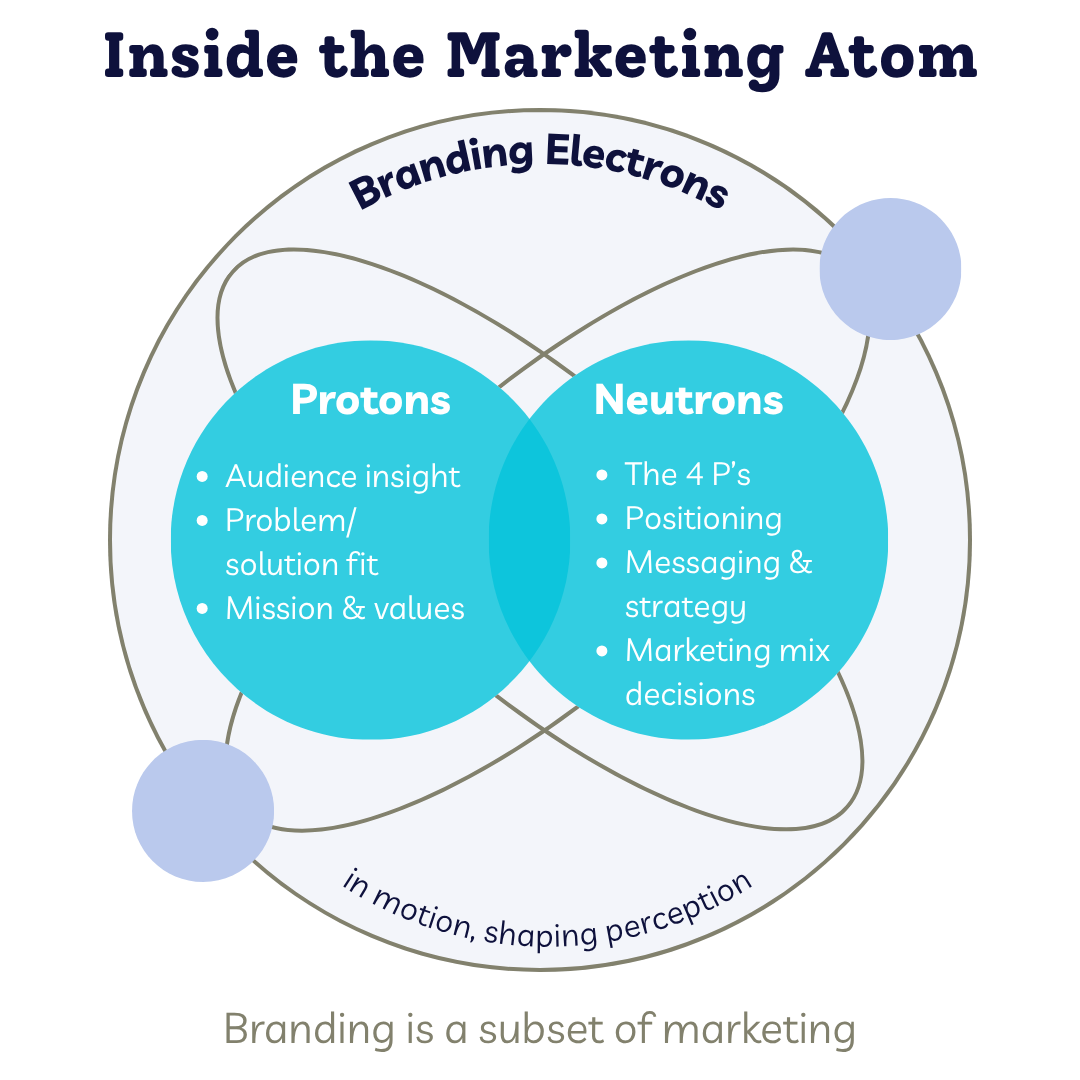
In other words, marketing is the system that creates value and connection, defining what you offer, why it matters, and who it's for. Branding is the expression of that system, how it looks, sounds, and feels, and how it's remembered and emotionally understood by your audience. Together, they form a single, integrated strategy where one is incomplete without the other.
All branding activities (like defining your voice, visuals, values, and positioning) live inside the larger world of marketing. Marketing includes branding but also covers strategy, promotions, messaging, offers, campaigns, distribution, analytics, and more. Large organizations may have a separate branding department to ensure brand oversight, but it still typically falls under a CMO. Why? Because branding is a part of marketing. When you think of marketing as the entire ecosystem that guides how your business communicates value, branding becomes the catalyst or the energy that moves through it to shape perception, guide creative, and underscore meaning.
You can say that all branding is marketing, but not all marketing is branding. Or, to simplify in math terms: Branding ⊂ Marketing
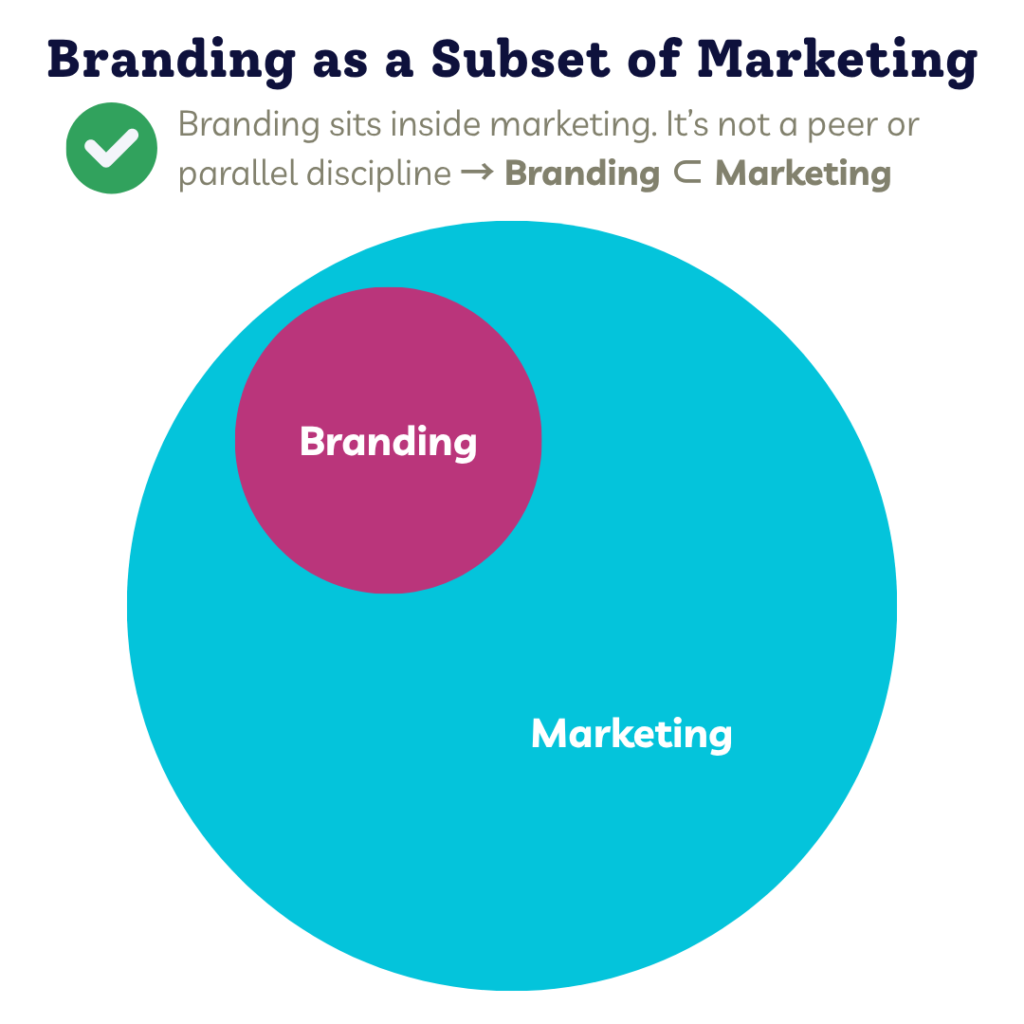

Another part of the confusion comes from the language we're all using. When people say "marketing" in those social media posts, they really mean promotion, aka the tactics used to get the word out: ads, content, social media, events. Like branding, promotion is just one part of marketing.
So, let's reframe the whole discussion with subsets:
Branding ⊂ Marketing
Promotion ⊂ Marketing
They're not competing. They're not even side-by-side. They're both inside marketing, the broader system that holds them. Misunderstanding this is like confusing one ingredient for the entire recipe or mistaking one puzzle piece for the whole picture.
Now: Unions and Why the Distinction
Another part of the confusion between branding vs. marketing comes from misidentifying the union relationship. A union (written as ∪) represents the combination of two or more sets, including their overlap.
While branding is a subset of marketing, it also intersects with other business functions like PR and communications, as does the whole marketing ecosystem. These aren't subsets of marketing per se, but they share space with it.
That's where we start seeing a union — shared elements that stretch across departments or functions. Many blogs and social posts mislabel branding and marketing as a union relationship instead of a subset relationship.
For example:
- Marketing focuses on external stakeholders, visibility, strategy, and growth.
- Communications and PR often include both internal and external stakeholders. Communications manages internal messaging, executive visibility, and employee engagement. PR manages public perception, media relationships, and reputation.
- Marketing uses PR and communications as tools, tactics, and/or channels for promotion and branding.
And branding? Branding is the thread that runs through all of them but lives in the marketing ecosystem. It influences how you show up:
- In your campaigns and content (marketing)
- In your internal memos and leadership voice (comms)
- In press coverage, investor decks, and public storytelling (PR)
So branding is:
- A subset of marketing
- Part of a union with comms and PR
- And a strategic throughline across everything your organization says and does
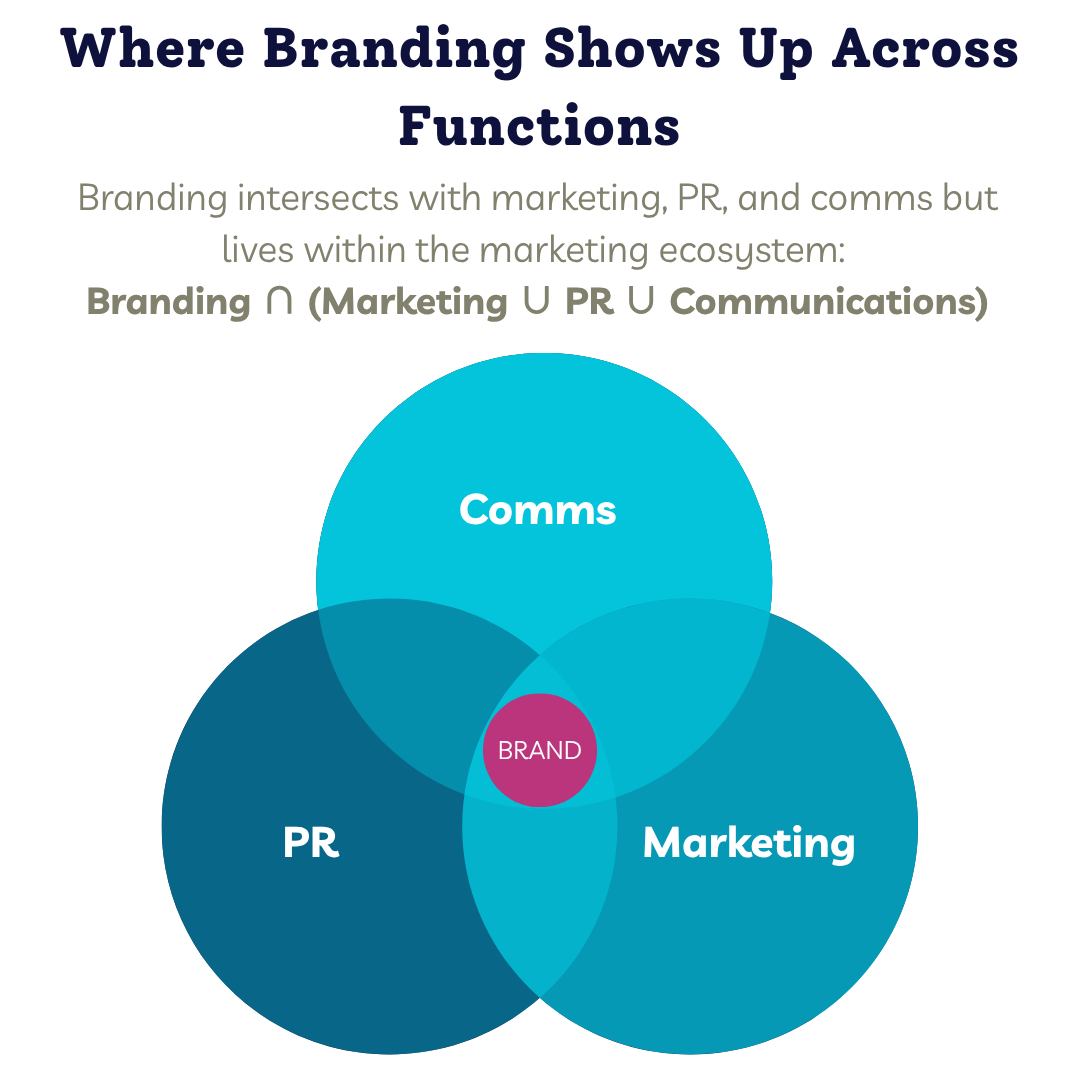
If that sounds like a lot, here's the takeaway: Branding isn't separate from marketing — it lives inside it. Yet, branding also overlaps with other functions that shape perception and communication. Getting this wrong or oversimplifying is why many campaigns fall flat or feel disconnected.
Now that we've reframed the relationship structure between marketing and branding, it's time to revisit what marketing includes.
What Is Marketing, Really?
We've touched on this already, so let's recap. As previously noted, marketing is often mistaken for promotion. Campaigns, funnels, ads, social content, or awareness tactics are pieces of the marketing puzzle. At its core, marketing is the strategic system that connects your business to the people you want to serve. It's how you create, communicate, deliver, and exchange value to that audience.
The activity, set of institutions, and processes for creating, communicating, delivering, and exchanging offerings that have value for customers, clients, partners, and society at large.
American Marketing Association
'The American Marketing Association defines it as: "The activity, set of institutions, and processes for creating, communicating, delivering, and exchanging offerings that have value for customers, clients, partners, and society at large."
This definition reinforces that marketing isn't in a silo. It's a dynamic ecosystem that builds awareness, fosters connection, drives engagement, and generates demand. It includes everything from strategy to execution and research to reporting. It's how you:
- Understand your audience
- Identify their problem
- Position your solution
- Communicate why it matters
- Deliver that solution in a way that builds trust, connection, and results
All of that requires alignment between:
- Your business mission
- Your customer insight
- Your product or service strategy
- And the way you show up in the world
The Marketing Mix (the 4 P's) is at the heart of that system. It's a classic way to visualize this system:
- Product – What you're offering and how it solves a problem or meets a need
- Price – How you reflect the value of what you're offering
- Place – Where and how your offer is accessed or delivered to your audience
- Promotion – How you communicate with your audience and raise awareness, engagement, and demand
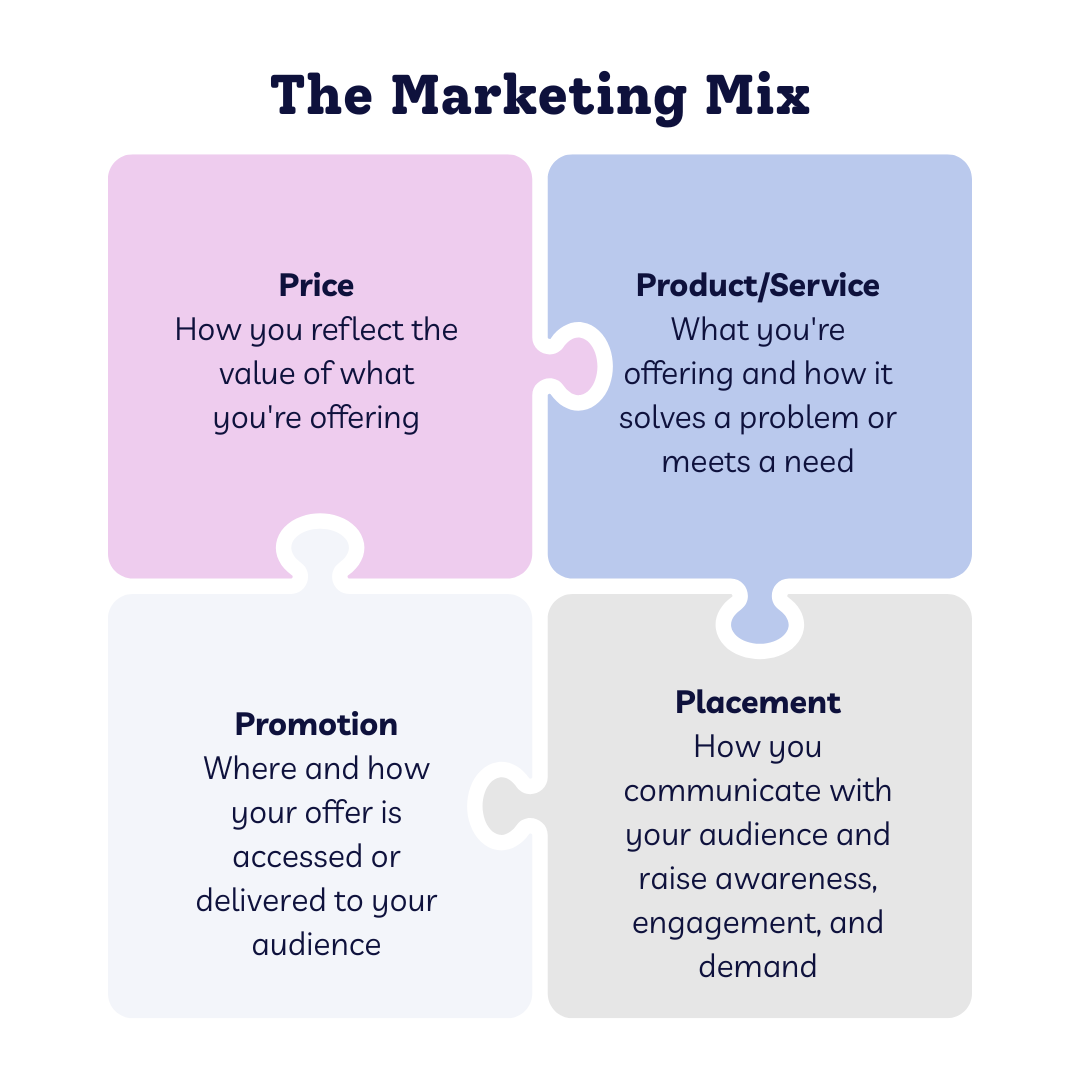
But the 4 P's still don't capture the whole picture. Marketing isn't just what you put on a billboard. It's the engine that drives the idea to execution and insight to impact. Inside this ecosystem, you also have:
- Research and segmentation
- Buyer journeys and funnel stages
- Channel strategy and timing
- Retention and relationship-building
- Metrics, analytics, and optimization
- And yes — branding
Where Branding Fits in Marketing
Branding is more than a logo, typeface, color palette, or tagline. It's how your marketing shows up. Branding is a strategic component developed inside the marketing process based on the audience you're trying to reach and the value you're trying to communicate that shapes how people experience your business and how they remember it.
Your messaging, visual identity, voice and tone, positioning, brand experience, and values are all brand expressions built through a marketing lens, and they exist to influence perception.
At the end of the day, your brand is not just what you say you are. It's how your audience experiences and perceives you. When there's a gap between what's expressed and what's received, it's more than a branding issue. It's a marketing problem. Marketing is the system that steers the brand, keeps it aligned with the audience, and closes the gap between perception and reality.
When the marketing ecosystem lacks the frameworks that define your brand, you get directionless marketing. Campaigns don't resonate, messaging misses the mark, and trust is harder to build. And when a "brand" is built in isolation, without connection to real audience insight, product strategy, or channel alignment, you get surface-level identity without substance. Branding that looks good but doesn't perform. Building branding within the marketing ecosystem, not beside it, creates clarity, consistency, and traction. That's why so much of the "branding vs. marketing" conversation online falls flat. It's based on a false separation that doesn't hold up in practice.
What does this look like in practice? The components of branding — things like your messaging, positioning, voice and tone, visual identity, and values — are developed within the marketing ecosystem. They emerge from foundational marketing decisions like understanding your audience, defining your value proposition, crafting your offer, setting your price, and choosing where and how you show up.
These brand components touch every part of the 4 P's. They influence how you position your product or service, how your pricing is perceived through your value narrative, how you choose placement through market fit, and how you approach promotion through your tone, visuals, and message clarity. When those strategic elements are intentionally aligned to guide how people perceive and experience your business, it becomes the connective tissue that brings your entire marketing strategy into focus.
But if that's how branding and marketing work, why do so many people still get it wrong?
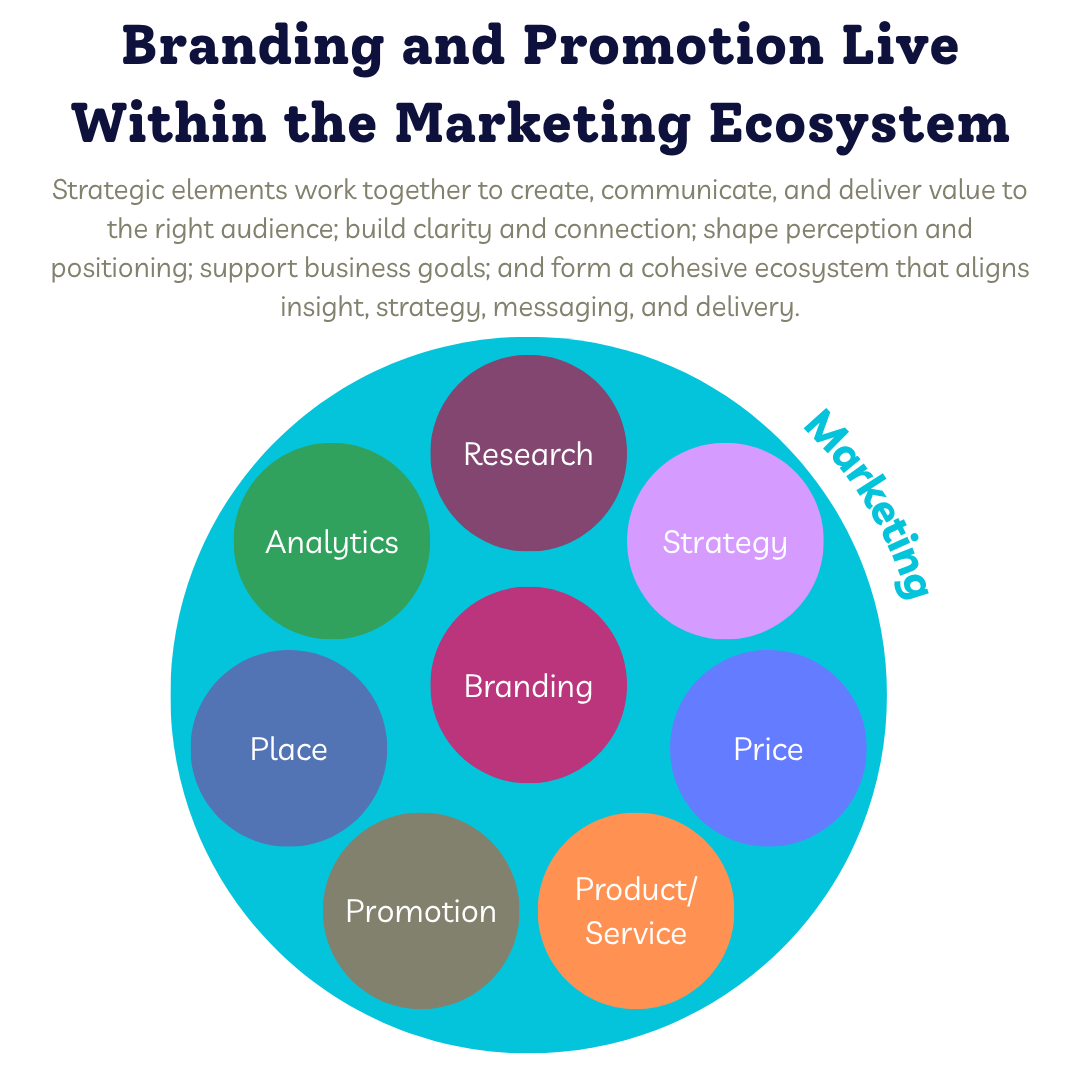
What does this look like in practice? The components of branding — things like your messaging, positioning, voice and tone, visual identity, and values — are developed within the marketing ecosystem. They emerge from foundational marketing decisions like understanding your audience, defining your value proposition, crafting your offer, setting your price, and choosing where and how you show up.
These brand components touch every part of the 4 P's. They influence how you position your product or service, how your pricing is perceived through your value narrative, how you choose placement through market fit, and how you approach promotion through your tone, visuals, and message clarity. When those strategic elements are intentionally aligned to guide how people perceive and experience your business, it becomes the connective tissue that brings your entire marketing strategy into focus.
But if that's how branding and marketing work, why do so many people still get it wrong?
Why the Confusion Exists
A big part of the confusion is due to how we talk about marketing and how oversimplified that conversation has become, especially online.
Here's what's fueling the disconnect:
- Tactic-driven marketing culture - In the age of quick wins and growth hacks, marketing gets reduced to campaigns, funnels, content, social, and other tactics. Branding gets sidelined as "just visuals."
- Siloed teams and vendors - When creative and marketing are siloed, they often operate with different goals and measures of success. Designers and creative leads focus on expressing brand identity and ensuring consistency across touchpoints. Marketing teams handle strategy, messaging, channels, and audience engagement. But without alignment, you end up with beautiful assets that don't support strategy or campaigns that don't reflect the brand. The disconnect limits both impact and cohesion.
- Misinformation on social media - Carousels, hot takes, and "vs." graphics get attention, but they also oversimplify. The problem? Oversimplification becomes accepted knowledge. It spreads fast, especially in spaces where nuance takes a backseat to virality. You don't need a degree to work in marketing, but that doesn't mean you can skip depth, context, or critical thinking. Surface-level content might get clicks, but it rarely builds competence. Everyone thinks they can "do" marketing, but not everyone takes the time to go deeper and understand the whole picture.
- Over-reliance on visuals – Many people confuse branding with logos, fonts, and colors. While those design elements are expressions of a brand, they're not the brand itself. That's like confusing the paint color for the aesthetic. It contributes to the overall feel, but it's just one piece of the identity and doesn't include the strategy behind it.
- Terminology confusion - A lot of the viral content uses the word marketing when it really means promotion. The logic of "branding is why, marketing is how" breaks down because it's built on the wrong definition.
The "branding vs. marketing" narrative might sound smart in a scroll — but in practice, it leads to fragmented teams, misaligned" efforts, and a strategy that doesn't hold together.
The truth is that the whole system works better when branding is built inside marketing and guided by strategy. Messaging aligns. Teams stay focused. The business shows up clearly and consistently. And yes, results improve.
The truth is that the whole system works better when branding is built inside marketing and guided by strategy.
What Happens When You Treat Branding as Separate
What happens when branding is treated like it lives outside the marketing ecosystem? You start to see symptoms like:
- Campaigns that look great but don't convert
- Messaging that feels off, inconsistent, or confusing
- Social content that sounds nothing like your website or sales materials
- Teams or vendors working in silos with no clear direction
- A reactive brand, not rooted in strategy, constantly changing tone, look, or focus
These issues stem from treating branding and marketing as separate systems instead of an integrated, strategic whole, not just from weak execution.
It's like designing a beautiful storefront without ever planning the layout inside. You might get people in the door, but the experience falls flat once they're there. It doesn't invite them to stay, build trust, or move forward.
Or worse:
It's like building a house where the architect and the contractor never spoke. The roof might be stunning. The foundation might be solid. But the structure doesn't quite work, and no one's sure why.
Disconnected marketing is often a symptom of disconnected strategy.
Branding isn't a layer on top of marketing. It's not a starting point, either. It's a strategic function that has to be developed within the marketing process, shaped by insight, informed by the audience, and aligned to business goals. When it's not, you don't just get poor brand perception. You get disconnected marketing. Disconnected marketing is often a symptom of disconnected strategy. A disconnected strategy usually starts when branding is treated as something separate. Branding in isolation becomes style without substance. Marketing without brand components becomes activity without clarity. This disconnect is one of businesses' most common and costly marketing problems. The good news? It's fixable. But only if you're willing to rethink how you approach your brand and strategy.
What This Means for Your Business
The issue is not only a semantic issue but also a strategic one. If your brand isn't built through your marketing strategy, you'll always chase clarity, consistency, and results. But when you treat branding as a strategic component within marketing instead of competing against it, everything starts to align.
5 Reflection Questions to Consider
You're not alone if you answered no or kind of to any of these. But it may be time to step back before you move forward.
If you want more effective, aligned marketing, it starts with your audience: who they are, what they need, and how you solve a real problem for them. And if you want your strategy to be consistent, your messaging to resonate, and your efforts to gain traction, that's where brand clarity under the marketing lens matters because the branding components align audience perception with the reality of your marketing. And when that alignment clicks? You get trust, results, and momentum.
And that's precisely where Maison Peters comes in.
Ready to Bridge the Gap?
When the brand elements within your marketing ecosystem align with your strategy, audience, and offer, everything becomes clearer: your messaging, value, and next move.
If you're ready to bring clarity to your marketing ecosystem from the inside out, here are two ways to get started:
📍 Book a 360° Strategic Clarity Audit
This high-impact, comprehensive custom marketing and brand audit helps uncover blind spots, disconnects, and growth opportunities.
💬 Need a quicker gut check?
Try a 1-Hour Strategy Session to explore where you're misaligned and how to fix it.
Or start small: Ask yourself if your next campaign is rooted in a clear marketing strategy — one aligned with your goals, audience, mission, and value proposition.
If it's not, it may be time to change how you re-evaluate your marketing altogether.








